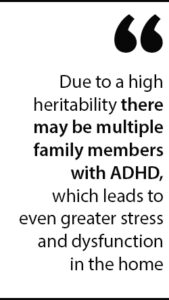Understanding ADHD and its impact
Are you familiar with attention deficit hyperactivity disorder (ADHD) in your practice? It is quite common and you may have encountered it without even realizing. While the classic image of ADHD involves hyperactivity and impulsivity, there are many aspects that can go unnoticed. Children and adults with ADHD may not receive the necessary recognition and support, leading to challenges in their daily lives.
Have you come across attention deficit hyperactivity disorder (ADHD) in your practice? It is so common it would be almost impossible not to. A safe bet would be that you have come across it more often than you realise. There are the “well-known” aspects of ADHD, the classic image of the hyperactive child “bouncing off the walls”, unable to sit still or focus on anything. But, there is a lot that can go unrecognised. Sometimes children and adults fall through the cracks, and may have secondary issues treated, while ADHD goes unnoticed.
 What is more, the impact of ADHD, across many, if not all, areas of life, means its effects can be found in doctors’ offices, hospital emergency rooms, courts of law, the Social Welfare Office, the family home, entrepreneurial roadshows, as well as the stereotypical image of the school principal’s office.
What is more, the impact of ADHD, across many, if not all, areas of life, means its effects can be found in doctors’ offices, hospital emergency rooms, courts of law, the Social Welfare Office, the family home, entrepreneurial roadshows, as well as the stereotypical image of the school principal’s office.
ADHD is a neurodevelopmental disorder characterised by hyperactivity, impulsivity, and/or inattention.1
It affects approximately 5-6 per cent of children.2 While there is some variability, and both severity of ADHD and comorbidity have an impact, for those diagnosed in childhood, the majority will continue to meet the diagnostic criteria or struggle as a result of their ADHD into their adult life.3,4
Presentation of ADHD
According to the Diagnostic and Statistical Manual (DSM5),1 ADHD presents itself in one of three ways, with diagnostic rates varying based on presentation.
One epidemiological survey found that in childhood, the combined presentation (hyperactivity-impulsivity-inattention) was the most common, followed by hyperactivity-impulsivity, with the inattentive presentation being the least diagnosed.5
Inattention may go unrecognised, because these children do not fit into that stereotypical view of the hyperactive child; as a parent once said to me, “I couldn’t believe he had ADHD, sure he’s almost horizontal …’. These children and adults can lose focus often and easily, may process information more slowly, forget or lose things frequently, and may seem like they live in a daydream and/or in chaos.
Diagnosis
ADHD is far more commonly diagnosed in boys in childhood, about five to one in most studies, however, diagnostic rates even out between genders in adulthood to a 1:1.6
At one point, this was attributed to the fact that girls tend to present with inattention and internalising problems (e.g., anxiety and depression), and with less externalising difficulties (e.g., hyperactivity).7
These ‘quiet’ children are often not disruptive at home and in school, and so they may fly under the radar.
However, other factors may also be involved,
evidence from the Zurich Cohort Study suggests that symptomatology varies (across genders) in early adolescence, with symptoms not becoming apparent for many girls until this age.
However, other factors may also be involved, evidence from the Zurich Cohort Study suggests that symptomatology varies (across genders) in early adolescence, with symptoms not becoming apparent for many girls until this age.8
This creates challenges for diagnostic guidelines, which require presentation before the age of 12 years.1 Moreover, there is clearly a need for greater recognition for ADHD in girls, indeed, for anyone with the inattentive presentation.
Understanding ADHD
To understand ADHD, we must consider its impacts, that is, how it affects the lives of those with the condition, the people closest to them, and to the wider community. ADHD can have detrimental effects across many, if not all, areas of life, which has consequences not only for the person, but also for society (e.g., impacts on social welfare and the criminal justice system).
A compressive review would take too long to set out, and so a select few are considered here.
Children with ADHD tend to have poorer social skills, be less liked by their peers, have fewer friends, and experience rejection from an early age.10,14
 This — together with risk-taking behaviours described above — may be linked with tendencies to associate with more deviant peer groups in adolescence.15 Children with ADHD have been found to be more likely to be both victims and perpetrators of bullying.16
This — together with risk-taking behaviours described above — may be linked with tendencies to associate with more deviant peer groups in adolescence.15 Children with ADHD have been found to be more likely to be both victims and perpetrators of bullying.16
Children with ADHD who also present with aggression may be even more likely to be victimised. These types of behaviours seem to be viewed by their peers as particularly unacceptable, and so the child with ADHD is targeted as a result.
There is some relationship between ADHD and the perpetration of bullying. However, we might need to be cautious on this one, because children with ADHD might respond to victimisation with aggression, and as a result be viewed by teachers as bullies.17 Conversely, positive relationships characterised by acceptance and understanding, may provide much-needed buffers for people with ADHD.7
Unfortunately, however, other relationships also seem to be characterised by conflict, such as those with teachers and family members.14
Indeed, ADHD is associated with greater family dysfunction – having a child with ADHD can cause a lot of stress for parents and siblings, and can contribute to conflict and financial difficulties (e.g., sometimes one parent cannot work, treatments often cost money, or lost items need to be replaced).
Parents might struggle with their own sense of parent efficacy, such as viewing themselves as a ‘bad mother’ and they might feel stigmatized and judged by others, and so isolate themselves.14
Due to high heritability there may be multiple family members with ADHD in the home, which leads to even greater stress and dysfunction in the home.
Adults with ADHD may struggle to stick to routines, provide structure, and remain calm, which are essential skills when raising a child with ADHD.18
As a result, intervention may need to adopt a holistic approach, providing support for the whole family and, where necessary, providing parents with treatment for their own ADHD-related challenges.
The majority of children with ADHD experience some degree of academic dysfunction, independent of their intellectual ability. These students are more likely than their non-disorder peers to experience failure, be held back a year, and drop out of secondary school.15,19
A longitudinal study in the USA found that students with ADHD were less likely to attend university.20 However, findings consistently point to two predictors: “academic problems” and “disciplinary problems”; students with ADHD who also have higher levels of one or both of these, are less likely to progress to third level.20
These findings are significant, because if we know what areas to target we can provide educational and healthcare interventions, to support children with ADHD completing their education, which has benefits not only for them, but also for society. Indeed, given these issues in education it is unsurprising that occupational outcomes are also not as positive for those with ADHD. Adults with ADHD are more likely to earn less, be unemployed, and either get fired or “job hop”.15,20
ADHD’s strengths
Perhaps one of the least acknowledged effects of ADHD would be its strengths. The ADHD community boasts many famous and talented people among its ranks from entrepreneurs and inventors, to musicians and actors.
A question has always been do these people succeed because of their ADHD or in spite of it? While this research area is definitely in its infancy, a survey of 174 experts across 11 disciplines and 45 countries identified a range of positive attributes, such as creativity, energetic, fun to be around, the ability to be flexible and multi-task, along with resilience and risk-taking.7
 Another study found that university students with greater ADHD-like behaviours were more likely to have entrepreneurial intentions.9 Indeed, while risk-taking might be associated with concerns in adolescence (e.g., substance misuse or sexual behaviour), it is generally true that you have to be willing to take risks if you want to set up on your own.
Another study found that university students with greater ADHD-like behaviours were more likely to have entrepreneurial intentions.9 Indeed, while risk-taking might be associated with concerns in adolescence (e.g., substance misuse or sexual behaviour), it is generally true that you have to be willing to take risks if you want to set up on your own.
David Neeleman, founder of JetBlue, might have struggled with his ADHD in childhood, but credits his success in part to his willingness to take risks and think outside the box.21
A struggle to cope
Notwithstanding the enormous potential of people with ADHD, the condition tends to co-occur with other difficulties, indeed, this is the rule, rather than the exception.
As a result, in contrast to current trends around “living your best life” people with ADHD often struggle to cope. They may feel more stress and overwhelmed trying to live up to social expectations.7,14
It is possible that this struggle to cope, in part, is responsible for the fact that ADHD is linked with a range of psychosocial difficulties and disorders.
People with ADHD report more negative self-concepts and lower self-esteem, as well as higher levels of anxiety, depression, self-harm, and suicide.7,10,11 ADHD is also linked with externalising problems. A substantial body of evidence suggests that there are higher percentages of people with ADHD-like behaviours in incarcerated populations, than in the general population.13
This link is unlikely to be based on chance alone. However, what this research finding does not show is whether these people had received any specific support earlier in life, leaving one to wonder if these longer term outcomes are linked to untreated ADHD.
All people are ‘packages’
We are all a ‘package’ — made up of strengths and difficulties — and this is no exception for people living with ADHD. However, people with ADHD may experience a lot more challenges and struggle to cope with the demands of life.
Indeed, the quality of life and outlook across a range of critical areas for those with ADHD looks pretty bleak. Is it any wonder then that people with ADHD also have a lot of psychosocial difficulties? One of the most frustrating aspects of all of this is that ADHD is extremely treatable.
With the right kinds of support and understanding, people with ADHD can go on to be successful and live happier lives. Perhaps Ireland’s next great entrepreneur is sitting in a classroom somewhere trying to focus on what her maths teacher is saying.
I sincerely hope she gets the supports she needs and deserves. This requires identification and a multimodal approach to treatment, with healthcare professionals working in partnership with other stakeholders (e.g., schools, patient organisations, etc.). ![]()
Author
Dr Kate Carr-Fanning is a Senior Lecturer in the School of Psychological, Social, and Behavioural Sciences in Coventry University, UK.
References
- American Psychiatric Association (2013). Diagnostic and Statistical Manual (5th Ed.).
- Polanczyk, G. et al. (2007). The worldwide prevalence of ADHD: a systematic review and metaregression analysis. Am. J. Psychiatry, 164(6), 942-948.
- Uchida, M. et al. (2018). Adult outcome of ADHD: an overview of results from the MGH longitudinal family studies of pediatrically and psychiatrically referred youth with and without ADHD of both sexes. J. of Attention Disorders, 22(6), 523-534.
- van Lieshout, M. et al. (2016). A 6-year follow-up of a large European cohort of children with attention-deficit/hyperactivity disorder-combined subtype: outcomes in late adolescence and young adulthood. Eur. Child Adolesc. Psychiatry, 25(9), 1007-1017.
- Larsson, H. et al. (2011). Developmental trajectories of DSM-IV symptoms of ADHD: genetic effects, family risk and associated psychopathology. J. Child Psychol. Psychiatry, 52(9), 954-963
- Kooij, S.J. et al. (2010). European consensus statement on diagnosis and treatment of adult ADHD: The European network adult ADHD. BMC Psychiatry, 10, 67.
- de Schipper, E., et al. (2015). A comprehensive scoping review of ability and disability in ADHD using the International Classification of Functioning, Disability and Health-Children and Youth Version (ICF-CY).
